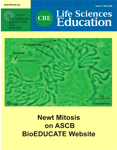Recent Research in Science Teaching and Learning
This feature is designed to point CBE-LSE readers to current articles of interest in life sciences education as well as more general and noteworthy publications in education research. URLs are provided for the full text of open-access articles and for the abstracts of articles not freely available.
EDUCATION RESEARCH AND PRACTICE ARTICLES
1. Gibbs, M. G., and Berendsen, M. (2007). Effectiveness of amateur astronomers as informal science educators. Astron. Educ. Rev. 5, 114–126.
[Open access: http://aer.noao.edu/cgi-bin/article.pl?id=228].
This study documents teachers' perceptions of the value of amateur astronomers' involvement in classroom learning. Teachers who hosted either amateur or professional astronomers reported equally positive changes in their students' attitudes toward science. Teachers also perceived that amateur and professional astronomers were equally effective in addressing students' misconceptions about astronomy. Based on these results, Gibbs and Berendsen argue that amateur astronomers, who greatly outnumber professionals in the field, represent a largely untapped pool of experts who can collaborate with science teachers in enhancing precollege students' learning.
2. Thiry, H., Laursen, S. L., and Hunter, A.-B. (2008). Professional development needs and outcomes for education- engaged scientists: a research-based framework. J. Geosci. Educ. 56, 235–246.
[Not open access. Abstract: www.nagt.org/nagt/jge/abstracts/may08.html#v56p235].
Thiry and colleagues describe the results of a qualitative research-with-evaluation study that examines the needs of scientists with respect to their engagement in K-12 education. Study participants were scientists enrolled in professional development (PD) workshops with an inquiry focus (i.e., inquiry as content, process, and nature of science). The needs that emerged through the analysis were: motivation (i.e., scientists' reasons to participate in education-related PD), accessibility (i.e., education-related PD is largely unavailable), knowledge and skills (i.e., scientists need to learn about teaching and learning), relevance (i.e., this learning should relate to the day-to-day priorities of practicing scientists), broad participation (e.g., teachers and scientists collaborating in their participation), and follow-up support after the PD. Based on these findings, the authors make recommendations regarding elements that should be considered in the design of education-related PD for scientists.
3. Windschitl, M., Thompson, J., and Braaten, M. (2008). Beyond the scientific method: model-based inquiry as a new paradigm of preference for school science investigations. Sci. Educ. 92, 941–967.
[Not open access. Abstract: www3.interscience.wiley.com/journal/117880230/abstract].
In this essay, Windschitl and colleagues summarize the major challenges regarding teaching of “The Scientific Method” (TSM) in classrooms, including how TSM fails to reflect authentic science and fosters misconceptions about the nature and processes of science. The authors articulate several distinctions between authentic science and TSM, for example, the focus on “testing ideas” rather than “testing variables.” The authors then propose “model-based inquiry” (MBI) as an alternative framework for school science investigations. As described, MBI involves students in a series of conversations: (1) organizing what we know and what we want to know, (2) generating testable hypotheses, (3) seeking evidence, and (4) constructing an argument. The essay concludes with examples of MBI in action and discussion of its limitations.
LIFE SCIENCES EDUCATION ARTICLES
4. Brown, B. A., and Ryoo, K. (2008). Teaching science as a language: a “content-first” approach to science teaching. J. Res. Sci. Teach. 45, 529–553.
[Not open access. Abstract: www3.interscience.wiley.com/journal/117955031/abstract].
In this study, Brown and Ryoo aim to separate the conceptual and linguistic components of science instruction and examine the impact of this approach on students' learning. The authors randomly assigned elementary students in a school to control or treatment groups, both of which completed a web-based lesson on photosynthesis without the involvement of a teacher. The lesson for the treatment group was “disaggregated” in that the science content was taught using everyday language and the scientific language was taught separately. The control group experienced an aggregated lesson, during which the language of science was used in teaching the content. The treatment group showed greater knowledge gains as measured using a multiple-choice test administered using a pre/posttest design. The treatment group's gains were more dramatic on an open-ended test that required students to articulate scientific ideas (i.e., ideas were not offered as multiple-choice options).
I invite readers to suggest current themes or articles of interest in life science education as well as influential papers published in the more distant past or in the broader field of education research to be featured in Current Insights.
| Journal | Publisher | Mission | Typical content | Open access | Website |
|---|---|---|---|---|---|
| Astronomy Education Review, 2002 - | Association of Universities for Research in Astronomy, Inc. | Research-based improvement of teaching and learning in astronomy and space science | Practice, applied, essays, theoretical | ✓ | http://aer.noao.edu |
| Journal of Chemical Education, 1924 - | Division of Chemical Education, Inc., American Chemical Society | Improvement and updating of chemistry teaching through the sharing of ideas, information, and materials | Practice, applied, essays | Some | http://jchemed.chem.wisc.edu |
| Journal of Geoscience Education, 1980 - | Association of College & University Biology Educators | Publication of research concerning the pedagogy, assessment, and philosophy of teaching and learning about the geosciences | Practice, applied, essays, theoretical | One year after publication | www.nagt.org/nagt/jge/index.html |
| Journal of Undergraduate Neuroscience Education, 2002 - | Faculty for Undergraduate Neuroscience | Peer-reviewed innovations in undergraduate neuroscience education | Practice, applied, essays | ✓ | www.funjournal.org |
| Physics Education, 1966 - | Institute of Physics, (IOP) Publishing Limited | Developments and teaching methods for secondary and introductory undergraduate physics | Practice, applied, essays | Some | www.iop.org/EJ/journal/PhysEd |



